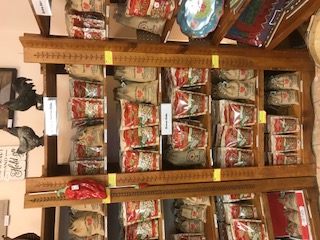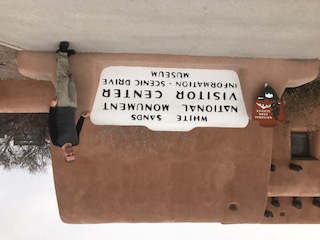Can't We All Just Get Along???
- Admin
- Jan 26, 2018
- 8 min read

"A good neighbor is a fellow who smiles at you over the back fence,
but doesn't climb over it"
Arthur Baer
State 26: New Mexico - January 7, 2017
Lori
We woke up at a Walmart in Bernalillo, NM, ready for an exciting new day! Today, we drive 225 miles South to Alamogordo, NM for the Cross Country Couple's "Made in the USA" tour for New Mexico; Heart of the Desert Pistachio Farm & Winery. George and Marianne Schweer loved the desert, and decided to retire in the Tularosa Basin in Southern New Mexico. The family had previously been farmers in Nebraska, and wished to return to their roots! However, they soon faced a huge obstacle to their ambitions; What will grow in the desert? After looking into a wide variety of crops from peaches to chili peppers, none were compatible with their climate! The Schweer's search for their desert cash crop ultimately lead them halfway around the world to the Middle East! Iran not only has a similar climate as Southern New Mexico, it also has a long history of growing pistachios! Further research revealed there are only 2 places in the US with a compatible climate to grow pistachios; Central California and Southern New Mexico. After purchasing a small pistachio grove of 400 trees in Alamogordo, NM in 1972, the Schweer's officially became pistachios farmers! They actually sold their first year’s pistachio harvest to local residents off their dining room table! From these humble beginnings, the farm has grown over the years to 13,000 pistachios trees, a vineyard of 24,000 grapevines, a 1500 sq. ft. retail store, and a 15,000 sq. ft. pistachio processing plant. Today, Heart of the Desert has the distinction of being New Mexico’s first and largest pistachio farm! The tremendous growth of their business over the years can be attributed to the Schweer's family business philosophy of: providing a healthy premium product, being an asset to the community, providing jobs for good people, and preserving American agriculture. Please see the pictures below!
I love pistachios! They are low in saturated fat, cholesterol free, high in protein, high in fiber, and are absolutely delicious! As a little girl, I remember sitting in my backyard at a picnic table and sharing a big bowl of pistachios with my mom. However, I know absolutely nothing about pistachio farming, and have been looking forward to visiting this farm to learn more! After watching a brief movie, our guide April gave an overview about the history of the company. Next, she led us out to the pistachio grove, and taught us all about pistachio farming!

The pistachio is a small tree reaching only 30 feet tall at full maturity after 15 to 20 years. Once fully grown, each female tree produces between 20 to 40 pounds of pistachios. The productive life of the pistachio tree is extremely long lasting. In the Middle East, the oldest productive pistachio tree on record is 726 years old! The first thing to know about pistachio farming is there are male and female trees. The males only pollinate, and females are the trees which yield the pistachio nuts. One male tree can pollinate up to 10 female trees! The pistachio trees are dormant from December through February, and begin to bloom with the arrival of warmer weather in late March. The male pollinates the female via the April winds, and the shell of the nut is fully developed by mid-May. Before June ends, the seed inside the shell have begun its rapid expansion, and by the first of August, the seed has filled the shell. The nuts are usually harvested the first week of September. Then, the Cross Country Couple shows up at the farm to eat a handful of delicious farm fresh pistachios!
Heart of the Desert handles their entire production on site from farming to shipping. The pistachios are harvested by a machine, which shakes the trunk of the tree causing the pistachios to fall on to a tarp beneath. Next, the pistachios are loaded into a large wooden bin, brought into their processing plant, and run through a series of machines, which sorts them into size and grade. I always thought pistachios cracked open during the roasting process, and was very surprised to discover most pistachios actually open naturally while on the tree! To separate the open pistachios from those remaining closed, they have a very large machine consisting of thousands of needles on a large rotating metal drum. The needles latch onto the nuts with the open shells and deposit them into one bin, the closed shell pistachios fall to the bottom the drum entering a separate bin. The machine successfully separates 98% of the open and closed shelled pistachios from each other. However, to remove the remaining 2%, the open shelled pistachios are fed on a conveyor belt, where 4 ladies hand pick out the remaining 2% of the closed shell pistachios. What a painfully mundane job! I don’t know how these ladies do this for 8 hours day after day! The open shell pistachios are then sent to the seasoning department where they are flavored, roasted, cooled, packaged and shipped all around the world. However, the closed shelled pistachios have a much different fate. They are loaded into a machine which cracks open the stubborn shell, and then fed into another machine separating the piece of shell from the meat of the nut. The pistachios are then packaged and sold as shelled nuts, or are used to create pistachio candy, ice cream, cookies, and other tasty treats.
By the time the tour ended, I was seriously jonesing for pistachios. I immediately made my way into the Heart of the Desert retail store where they offered endless ways to get your pistachio on! The gift shop was packed with all of the pistachio paraphernalia you heart desires. They had pistachio bowls, pistachio shirts, pistachio jewelry and so much more! Everywhere you looked there was pistachios, pistachios, and even more pistachios!!! They also had variety of pistachio ice-cream available. Nate and I shared two scoops of their smooth, sweet and creamy pistachio gelato, which was to die for!!! A wine tasting bar was located to the rear of the retail shop, which included a red wine infused with pistachio oil! To the rear of the wine bar was the most beautiful large shaded patio overlooking the pistachio orchards! Please see the pictures below.
Next, we made our way back to the retail store, to sample their various flavors of pistachios. Our favorite of the bunch was the garlic green chile flavored pistachios, and we purchased a ½ pound package. Nate and I ended up eating the entire bag before leaving the parking lot! The heat of the green chile combined with the garlic, and the meatiness of the nut created a flavor very reminiscent of a hot wing! As vegetarians, it has been years since either of us have had hot wings, and it was quite a nostalgic and delicious experience! When I finally find my new home, I am going to have to concoct a vegetarian version of a hot wings using pistachios, chile, and garlic!
I am beginning to notice our diet throughout our cross country trip changes with our geographical location. For example, we have been eating way more taco salads, and fajitas then typical while exploring the Southwestern states. It has become almost automatic to immerse ourselves in the culture and cuisines of the region as much as our vegetarian beliefs will allow. As we travel from state to state, I am also discovering our tastes and preferences are beginning to evolve as well, and we have unknowingly incorporated experiences from each state into our daily lives. For example, garlic green chile is not a flavor I would have ever actively sought out prior to this trip. However, it is a small token New Mexico bestowed upon us, which we will take with us to our new future home! This trip has changed us in ways we could have never imagined, and we probably will not come to fully realize until our year-long cross country journey is complete.
Nate
After departing the pistachio farm, we drove 16 miles Southwest to White Sands National Monument. Established on January 18, 1933 by President Herbert Hoover, White Sands National Monument encompasses 275 square miles of white sand dunes in the Tularosa Basin of Southern New Mexico. The reason for the existence of the white sand originates in its microscopic composition. Sand as we usually know it, consists of quartz-based crystals, but sand in the monument instead consists of gypsum crystals. Since gypsum is water soluble, it rarely occurs as sand as it dissolves when it rains. However, the Tularosa Basin has no outlet to a body of water, and when the water evaporates, gypsum sand crystals are left behind resulting in the largest white sand dunes on Earth! Another interesting factoid about gypsum white sand is it does not absorb the heat from the sun, and can be walked upon with bare feet regardless of the temperature! White Sand National Monument sounds like an amazing place doesn’t it? Well keep reading on….
The park is located adjacent to Holloman Air Force Base, and lays entirely within the US Military’s White Sands Missile Range. Wait, it gets even worse!!! The White Sands Missile Range was also the location of the Trinity Site where the world’s first atomic bomb was detonated!!! Unsurprisingly, the monument has always had a rocky relationship with its military neighbors. In 2008, White Sands National Monument was a candidate to become a World Heritage Site. However, the application was rejected on fears the parks designation would result in international pressure to halt military operations in the Tularosa Basin. Visitors have long complained of planes from Holloman Air Force base flying over, and disrupting the parks tranquility. Then, there is the risk of exposure to radiation from the nuclear detonation! In addition, the monument is regularly closed while missile tests are being conducted, which occurs a couple of times a week! There has even been instances of missiles going off target, and destroying some of the parks visitor’s areas!!!
Between the history of nuclear detonation and the neighboring military missile testing range, neither Lori nor I were overly thrilled about visiting the White Sands National Monument. While the park sounded amazing, we did not want to risk exposure to nuclear radiation or fall victim to friendly fire. On the other hand, the parks reviews were spectacular, and the online pictures were breathtaking! Most importantly, these white sand dunes are the largest of its kind anywhere in the world, and for that one reason alone we had to go! First, we needed to establish a few ground rules. We would check with the missile base to see if they were launching during our visit, which thankfully they were not. Next, we would drive only on the parks 8 mile loop road. With the exception of an emergency, we would not exit Rosie for any reason! Finally, we would keep Rosie’s windows up, and her AC turned off the entire time. With an agreed upon code of conduct out of the way, we entered White Sands National Monument! The white sand dunes were quite eerily beautiful, and we saw children eagerly sledding down them. New Mexicans are quite resourceful people who refuse to allow their warm climate to hinder their winter fun. Although I must say it was disturbing to see children picnicking and playing near the site of the world’s first nuclear detonation! Please see the pictures below!
After departing White Sands National Monument, we drove across town to the Walmart in Alamogordo where we slept for the night.












































































Comments